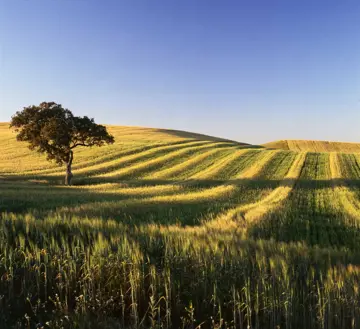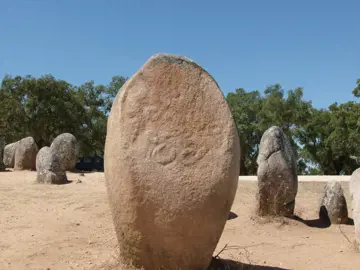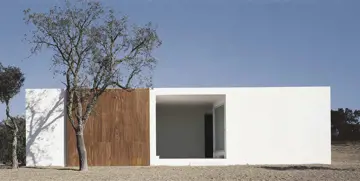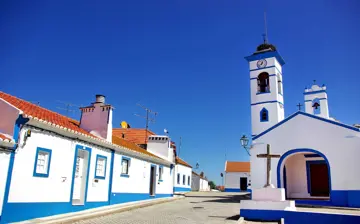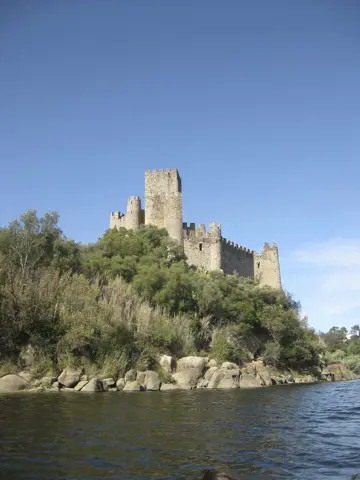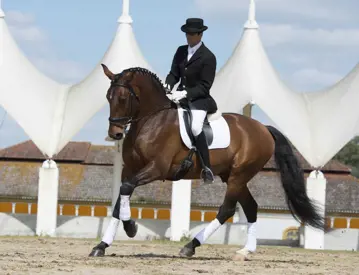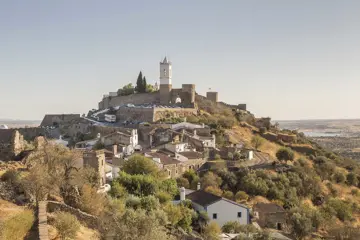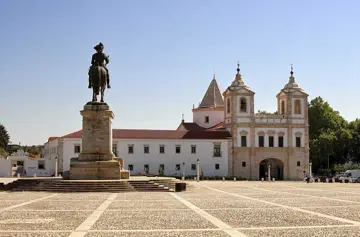Do you dream of silence, desolate landscapes and authentic villages full of age-old traditions? Then the Alentejo, one of Portugal's largest and most sparsely populated regions, is the ideal destination for you. 'Slow travel' in all its simplicity.
The vastness and unspoilt nature of Alentejo really come into their own from the mighty 14th-century castle in Castelo de Vide, one of the region's most beautiful towns. Another must-see along the way: releasing mares into the open pasture of the royal horse-breeding farm Coudelaria Altér Real. It is renowned for its Sorraia and Przewalski horses.
In the beautiful town of Estremoz, almost everything is made of marble. Not coincidentally, this was the favourite residence of kings and famous people. The remains of the royal palace now house one of the country's most famous pousadas (which are places to stay). Also on the programme: A visit to the university city of Évora, which is a Unesco World Heritage Site, and its aqueduct, imposing cathedral and Roman ruins. A drive through Planicia Dourada, the golden yellow 'land of plenty' where you will find the best olive oils and wines. And, of course, there is also time for a trip to the beach. How about the 25 km-long Praia da Comporta and its designer villas by renowned Portuguese architects? Make sure to take some time to visit Alcácer do Sal and the Reserva Natural do Estuário do Sado. Tip: for the most stunning holiday photos, visit the picturesque fishing village of Carrasqueira. There is certainly no shortage of bobbing boats!
Day 1 : Departure to Lisbon - Crato/Marvão
Today is the day. You enthusiastically pick up your rental car from the airport. You leave via Santarém, a beautiful spot on the banks of the Tagus River and well worth a visit, towards Abrantes. A few kilometres from here is the quiet village of Costância and the castle of Almourol, located on an island in the Tagus. Here you will spend two nights in a designer hotel.
Day 2 : Alto Alentejo
Explore the protected Serra de São Mamede Natural Park, a 1,000m-high ridge with an eagle's nest as its settlement town, Marvão. Ten kilometres away is Castelo de Vide, one of the most beautiful towns in the Alentejo. From the mighty 14th-century castle surrounded by the old Jewish quarter and a garland of whitewashed houses with steep streets, you have a phenomenal view of the wide plain of the Alentejo. The contemporary Castelo de Vide in the lower town is also worth a visit with its lovely houses from the 17th and 18th centuries. This region is also home to metre-high granite blocks with dolmens, burial chambers and menhirs. Portalegre is the gateway to the Serra de São Mamede and also has a beautiful location. The top attraction is the Museu da Tapeçaria Guy Fino housed in a beautiful mansion. Its carpet collection is world-class; even artists like Le Corbusier wished to see their work produced this way. The former São Bernardo monastery is also a must-see, with a vestibule in the church decorated with impressive wall-high azulejos and a tomb no less than 12m high.
Day 3 : From the royal horse breeding farm heading south
Near Alter do Chão is the royal horse breeding farm, the Coudelaria Altér Real. Sorraia and Przewalski horses, among others, are bred here in collaboration with other farms. Besides the breeding stallion centre and horse museum, the main attraction is the release of mares in the open pasture (afternoon). In the beautiful city of Estremoz, almost everything is made of marble, from the marble quarries nearby. Estremoz was the favourite residence of numerous kings and well-known people such as Vasco da Gama. The remains of the royal palace were converted into one of the country's most famous pousadas. You will stay three nights in Évora or in the region.
Day 4 : Marble and fortified towns
Head towards Monsaraz, another beautiful white fortified village perched on a high cliff with stunning views of the Guadiana River valley. Undisturbed silence and tranquillity reign here, and both sunrise and sunset are of rarely seen beauty. Via Vila Viçosa, an attractive town of white marble with a grand palace of the Dukes of Bragança, to Borba, where you will find the most important marble quarries up to 100m deep. On to Elvas, an important settlement town still within its ancient walls. The impressive aqueduct still supplies water to the south-west of the city. Return to your hotel with an optional stop en route at Evoramonte, situated like an eagle's nest and offering the finest panorama over the vast plains of the Alentejo.
Day 5 : Evora, Unesco World Heritage Site
Visit this enjoyable university town with its aqueduct, its imposing cathedral and its ruins of a Roman temple. You will discover Moorish influences everywhere, and the Igreja da Misericordia features stunning azulejo scenes.
Day 6 : Baixa Alentejo: olive oil, wine and cork
After visiting Beja, the capital of Baixa Alentejo, you will drive through the Planicia Dourada, the golden yellow lowlands dotted with cornfields, olive groves, vineyards and oak forests with numerous 'montes', which are the typical farmhouses. This is 'the land of plenty', a major agricultural centre where the best olive oils and wines come from, as well as wool and traditional cork. Continue towards the west coast to Santiago do Cacém, an important centre for the cork industry, with an interesting Museu Municipal. At 2 km are the Roman ruins of Miróbriga in a beautiful green setting.
Day 7 : The most beautiful beaches
The virtually intact coastline, where the ocean laps against the rocks or rolls out its waves on the beautiful beaches: you too will be captivated by all this overwhelming natural beauty. It is no coincidence that the 25km-long Praia da Comporta is a favourite holiday destination of the jet set, who discreetly retreat here in country houses or designer villas designed by renowned Portuguese architects. A must is a visit to Alcácer do Sal which, due to its strategic location - the open road to the ocean - has produced salt, cork and rice for centuries. In the centre, it is worth visiting the castle (pousada) and the Igreja Santa Susana, a 12th-century Romanesque church with a beautiful interior with azulejo panels and with a white tower on which storks nest. Alcácer do Sal is also the departure point to visit the Reserva Natural do Estuário do Sado, interesting not only for its birdlife but also for its old fishing villages and rich cultural heritage. Carrasqueira, for instance, is a photogenic fishing village with bobbing boats and plenty of seafood restaurants.
Day 8 : Going home
Your adventure comes to an end. After dropping off your rental car at Lisbon airport, you will fly home. Still craving for more? Extend your holiday by contacting us.
Why book with Caractère?
- Best price guarantee
- Caractère extras
- Just one phone call or email away from our enthusiastic travel experts
- Pay safely
- No extra or hidden fees

